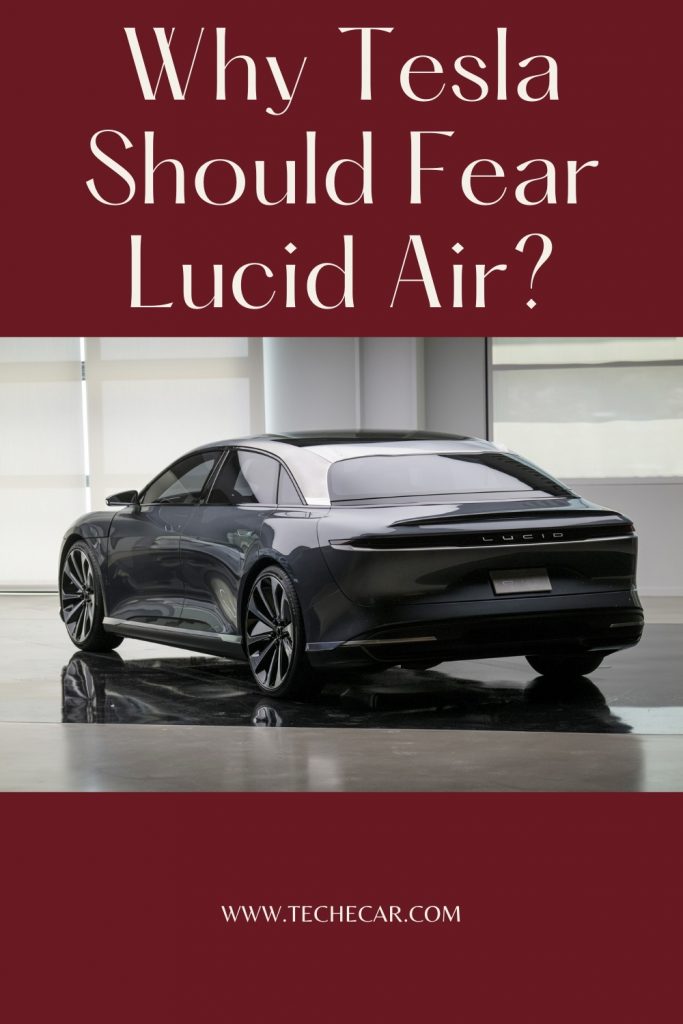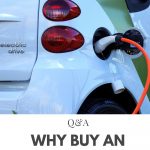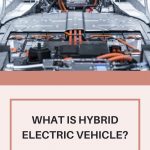Why Tesla Should Fear Lucid Air in 2021?


Topic: Why Tesla Should Fear Lucid Air?
American car company Lucid Motors introduced the first Lucid Air prototype in 2016. Hailed as the world’s most efficient luxury car with a range of 832 km, the sleek and futuristic Lucid is an intriguing entry into the disputed electric vehicle market.
The exclusive patented power plant, Lucid technology, is at the forefront of performance for electrified vehicles. Despite the ethereal name, Lucid has moved a lot of money, atoms, and current in the real world.
The company has received more than a billion dollars in financing. Lucid is building a 380,000-unit-per-year production facility in Casa Grande, Arizona. And the car runs on a 113 kWh battery with 900-volt architecture. The electric motor, reverse gear, transmission and differential are housed in a single miniaturized electric drive unit that weighs just 163 pounds and develops more than 650 horsepower.
What makes Lucid ready for a seat at the top table?
Despite Starship sized EV market caps, Lucid’s engineering organization stays focused on the technology. Lucid understands their first production car needs to be a technical tour de force. The luxury sedan claims to be 40% more efficient than any other electric car on the road. The Lucid Air travels 17% further than a Tesla model S long range for the same size battery pack. Detractors think the stats are just too good to be valid for a nascent car company.
Let’s take a look at innovative technology.
Lucid Motors puts up their cars and formulates our conclusions. Efficiency is the holy grail of electric vehicles and the North Star for Lucid Motors. Lucid’s main focus is getting more runtime for a battery of the same size. Lucid’s benchmark is miles per kilowatt-hour, and Lucid Air achieves approximately 4.6 miles of travel for every kilowatt-hour of energy stored in its battery.
By comparison, the long-range 2020 Tesla Model S only achieves about 4 miles per kilowatt-hour. Lucid airstairs 113 kWh battery pack contains industry-standard lithium-ion cells, but Lucid has incorporated advanced cooling systems and a proprietary cell architecture that reduces the internal impedance of the pack.
Lucid is not new to the drum kit. Originally founded as Atieva in 2007, the company designed, manufactured and supplied batteries and powertrains for other electric vehicles prior to their launch.
They manufactured the batteries for all the cars in the Formula E racing series for several years. It is true that the battery that we have here in the lucid air is a close cousin to the DNA of this racing battery. End cooling, tubular cooling plates, the way the honeycomb, the 60-degree honeycomb of the cells, is ultra-compact with the end cooling.
The ultimate test of a battery is fast charging. Featuring a 900-volt charger with maximum charge rates above 300 kW, Lucid Air is
capable of charging up to 20 miles per minute, or 300 miles of charging in just 20 minutes. Lucid’s two-way multifunctional booster charger, the Wunderbox, is only capable of charging the vehicle or vehicle-to-vehicle network, essentially allowing you to use your car as a giant home backup battery.
Higher capacity with larger and heavier batteries. For its 17% efficiency advantage over Tesla, Lucid attributes 15% to transmission improvements and 2% to aerodynamic optimizations. Lucid’s electric drive unit is one of the automaker’s most important innovations. There is a very. The weird fact that explains why, and it sounds so crazy you might not believe it.
Lucid motor, inverter, transmission and differential unit round out this drive unit, and this unit weighs just 74 kilograms. It can literally fit in an aeroplane flight bag. And it is two and a half times smaller than the closest competitor for its power.This unit can literally meet specs at 670 horsepower, but it weighs only 74 kilograms; it reaches more than 40 horsepower per litre. And we can use one, two or three combined in a lucid aerial platform.
It may only have a rear-wheel-drive; You can have a four-wheel drive with two motors or combine a third to have a tri-motor Engine has built a three-engine prototype that already performs spectacularly. We did a 9 second run at point 2 4, 9.24 stopping a quarter-mile.
The engine was boosted, hitting around 9.3 and hitting a quarter-foot exit speed of 158 mph with our tri-engine. This is a level of hypercar performance. One of the main catalysts is the Lucid motor thermal control and the revolutionary Lucid motors specifically designed to keep the temperature under control, especially in these copper windings that you see there through the stator slots.
When you use an electric motor, heat builds up. As the copper stator windings heat up, they generate more resistance, and electricity cannot flow as easily, reducing efficiency. Engine cooling is a major technical challenge in building an efficient electric vehicle.
Lucid tackled the cooling by running computer models of the electromagnetic fields with engines and identifying areas that could be optimized. They then used a computerized coil winding system with a continuous wave pattern that allows for more consistent and predictable motor performance. The Air Lucid uses permanent magnet synchronous motors that can rotate up to 20,000 rpm at the front and rear of the vehicle.
It was a significant engineering decision to go for permanent magnet motors, misusing induction motors, which rely on electrical current to magnetize the rotor. There is a concept related to permanent magnet motors called toothed torque. Notch torque refers to the interaction between the permanent magnets of the rotor and the grooves of the stator. The magnetic field generated
Because of permanent magnets it cannot be turned off.
Thus, the magnets constantly exert a torque that slows down the motor, especially at low speeds. In an induction motor, the magnetic field is generated electrically. When you turn off the power, the electromagnets do not exert any magnetic field and the motor can rotate freely. Lucid has brought innovations to the design of its PMMS motor that dramatically reduces tooth torque, maximizes power output and reduces electrical losses.
Lucid’s proprietary inverter uses a silicon carbide MOSFET chip to further maximize efficiency under real driving conditions.
La Lucid Air pourrait être la première voiture à battre l’efficacité du groupe motopropulseur de Tesla, mais Lucid ne voit pas Tesla comme un concurrent direct, et vous pourriez être surpris de savoir qui ils la considèrent comme la vraie concurrence, n’est- It is not?
The Lucid Air is a luxury car that views traditional German mainstays like the Mercedes S-Class as the real competition. 98% of the global luxury market includes internal combustion engine vehicles, but is the upper class ready for something electrified in the premium class?
but I think it takes a while for this style to develop in people; it’s like it’s a bit strange to start because it doesn’t look like a traditional car with a human face, you know if a comparison is that the human almost inspires the eyes of the traditional car, you see the face from the car, and you see a single lens to each lighthouse like human eyes.
They really are insect eyes, you know, like a fly’s eyes are hundreds and hundreds of microlenses, that’s what a fly sees. Lucid reinvents the proportions of luxury design by putting electrification at the forefront of its design thesis, not after the fact. You don’t need a long sweep hood with compact electric motors, a massive air intake, or a big shiny grille. Cult relics of freight transport from a 125-year tradition of luxury combustion engine design.
Lucid VP of Design Derek Jenkins says the future of luxury is streamlined, minimalist, and Will follows the principles of form and function. Lucid believes that the new era of electrification design language is still in its infancy and that an aesthetic revolution is underway.
If you come around the side of the car, you see the proportion of the lucid air is pretty unique we have a very short hood, really long cabin and a very short rear, and that’s possible because of the electric drivetrain we’ve been able to make the cabin for the passengers much larger then a vehicle normally in this size, so we end up with a car that’s in the mid-size category on the outside but the full-size category on the inside, and so that’s a big benefit.
Space won by compact powertrain components allow the Lucid Air to exist as a medium-sized car, with a full-size car interior, SUV levels of storage, and hypercar performance. The vehicles smaller frontal area and highly efficient vortex front air intakes create a streamlined aerodynamic signature, with a drag coefficient of just 21.
Lucid is focused on achieving more distance for less battery. This will make future vehicles more affordable because the battery is the most expensive part of the car. But the air is not a stripped-down sports car; it features high-end design elements for an aesthetically pleasing first-class driving experience.
You’ll also notice that we have a full glass canopy. This will be the largest glass canopy of any vehicle on the market next year, and it’s one a single piece of glass from the windshield wipers to the centre line, and then we pick up the second piece of glass around the rear.
The simple design theme carries through the back of the car; one of my favourite features is this cut line that comes off the cabin and cuts right through the back of the car, and creates this clamshell rear opening; it’s a super cool feature that makes the back of the car super clean no shut lines through the rear with just one continuous tail light across the back of the car.
Lucid takes a first-principles approach to interior design as well, rethinking the cabin for the driver experience. One thing that’s important about our the interior is our displays; early on, we studied how we wanted to have the display layout, and we opted not to go with the large central display but with something that was more curved and contoured and optimized really for the driver experience.
This screen is a 34-inch LCD screen, and its primary function is to focus information towards the driver, and you’ll notice it’s fully contoured in this direction and this direction. Thoughtful user experience design on top of a high-performance EV. But just how does high that does the digital speedometer go?
The Laguna Seca raceway in California has emerged as the ultimate proving ground to test electric vehicles’ performance with 2.2 miles of hairpin turns and unrestrained straightways; The famed track provides perfect real-world conditions to test EV attributes such as speed, acceleration, braking, and handling.
In 2020 unofficial track reports started coming in that a Tri-Motor Lucid air had bested Tesla’s track record by over 2 seconds, with a lap time of 1 minute and 33 seconds.
We heard that Tesla took the lead again, but this healthy competition in the EV world is exciting to see and undoubtedly drive the industry forward. With electric car manufacturers competing for bragging rights with souped-up race versions of their production cars, innovations learned on the track can translate into real-world performance enhancements, and the impressive displays build respect and notoriety for the electric vehicle market as a whole.
In July 2017, a modified performance version of the air hit a confirmed top speed of 235 MPH 378 km/h on the high-speed track at the Transportation Research Center in Ohio. Lucid is not just trying to build luxury hypercars for millionaires. The goal is for the optimizations made in high-performance EV powertrain design to trickle down to lower-cost Mass market vehicles. Lucid hopes to eventually produce the sought after $25,000 electric car.
Lucid has just finished 80 prototype vehicles and has a production target of 8-9000 vehicles by Spring 2021. They will accomplish this with a state of the art 700 million dollars, 6.1 million square foot EV factory in Casa Grande, Arizona, which is outfitted to produce 30,000 vehicles a year, with an eventual capacity target of 400,000 vehicles per year.
The Lucid Air will be available in 4 initial models, The Air Pure, $69,000, The Air Touring model from $87,500, the Air Grand Touring from $131,500, and the limited Air Dream Edition, available in spring 2021 for a starting price of $161,500. Whether Lucid is truly a worthy challenger to Tesla will come down to how well they deliver their final production car to market, on time, as
promised, and with all the bells and whistles.
The only answer I can have is to wait till next spring keep the scepticism, keep throwing the stones I’ve got i’ve got a strong chin. I welcome it because there’s a lot of bad actors out there; the only way we can prove we are real is to get this in production next spring and in customers hands and show, and that’s what i’m I can’t get to next spring soon enough to have that opportunity to show.
Recommended Articles:
How To Charge An Electric Car On A Road Trip?
How Fast Can An Electric Car Go?
How Many Solar Panels To Charge An Electric Car?
How To Fix Electric Car Window?





